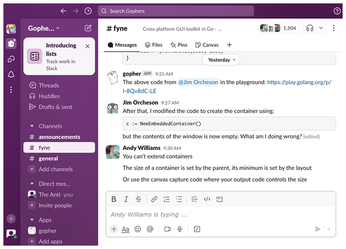Instant browser refresh with a WebSocket connection
Programming Snapshot – WebSockets

© Photo by Micah Tindell on Unsplash
The WebSocket protocol helps browsers to immediately reload a page if the server-side content changes. In this month's column, Mike Schilli whips up his own WebSocket server in Go for this task.
You may have wondered what kind of magic it takes for, say, a WhatsApp or Slack chat open in your web browser to respond so quickly to new input from your chat partner, or to show that your partner is typing … even before the message has been sent (Figure 1)? To do that, the browser at least needs to partially reload the page you are viewing, but how does it know when to do so?
In the simplest of cases, the browser could just periodically ask the server, but that would generate unnecessary network traffic – after all, nothing would have changed most of the time. This also would cause periodic flickering of what was a largely static page, which would look pretty unprofessional. For a better approach, you could turn the setup on its head and only wake up the browser if the file has changed at the server end.
[...]
Buy this article as PDF
(incl. VAT)
Buy Linux Magazine
Subscribe to our Linux Newsletters
Find Linux and Open Source Jobs
Subscribe to our ADMIN Newsletters
Support Our Work
Linux Magazine content is made possible with support from readers like you. Please consider contributing when you’ve found an article to be beneficial.

News
-
Cairo Dock 3.6 Now Available for More Compositors
If you're a fan of third-party desktop docks, then the latest release of Cairo Dock with Wayland support is for you.
-
System76 Unleashes Pop!_OS 24.04 Beta
System76's first beta of Pop!_OS 24.04 is an impressive feat.
-
Linux Kernel 6.17 is Available
Linus Torvalds has announced that the latest kernel has been released with plenty of core improvements and even more hardware support.
-
Kali Linux 2025.3 Released with New Hacking Tools
If you're a Kali Linux fan, you'll be glad to know that the third release of this famous pen-testing distribution is now available with updates for key components.
-
Zorin OS 18 Beta Available for Testing
The latest release from the team behind Zorin OS is ready for public testing, and it includes plenty of improvements to make it more powerful, user-friendly, and productive.
-
Fedora Linux 43 Beta Now Available for Testing
Fedora Linux 43 Beta ships with Gnome 49 and KDE Plasma 6.4 (and other goodies).
-
USB4 Maintainer Leaves Intel
Michael Jamet, one of the primary maintainers of USB4 and Thunderbolt drivers, has left Intel, leaving a gaping hole for the Linux community to deal with.
-
Budgie 10.9.3 Now Available
The latest version of this elegant and configurable Linux desktop aligns with changes in Gnome 49.
-
KDE Linux Alpha Available for Daring Users
It's official, KDE Linux has arrived, but it's not quite ready for prime time.
-
AMD Initiates Graphics Driver Updates for Linux Kernel 6.18
This new AMD update focuses on power management, display handling, and hardware support for Radeon GPUs.


